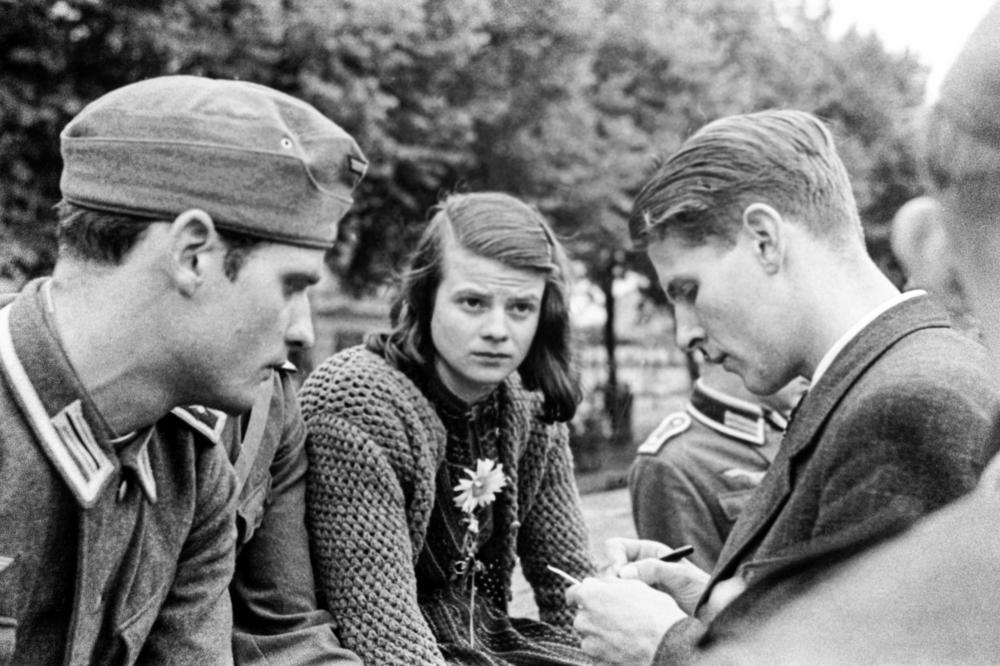Elisabeth Scholl waited for her bus at a café on February 23, 1943. The weekly newspaper Völkischer Beobachter’s headline grabbed her eye. She learned that her siblings, Hans and Sophie Scholl, had been killed the night before for high treason against Nazi Germany. Their heads and companion Christoph Probst were guillotined. Days later, their parents were jailed.
“Four more days until my 23rd birthday, and I feel like my whole world has crumbled,” she told the Daily Mail in mid-January 2014.
The executed siblings and their friends distributed flyers, graffiti, letters, and anti-Nazi stamps as White Rose (Weiße Rose) resistance activists.
The younger sister, Sophie Scholl, is credited with formulating the White Rose movement’s crucial choices.
Family Against Nazis
Born on May 9, 1921, Sophie Magdalena Scholl, the fourth of five siblings, co-founded the White Rose resistance organization with her brother Hans.
Their father, Robert Scholl, was a politician and administrative specialist from Forchtenberg. He was a moderate German People’s Party (Deutsche Volkspartei) member who opposed the Nazis. He was pious and decent.
Sophie and her siblings learned community and responsibility from their father. He taught students critical thinking by discussing politics, ethics, and social concerns.
Magdalena Scholl, her mother, stressed education and pushed them to study and learn about many things. Empathy, compassion, and righteous action were also taught.
Her parents’ Protestantism shaped Sophie’s morality. They taught her honesty, ethics, and conscience.
These beliefs defined Sophie Scholl’s character and her fight against Nazi Germany.
Her father became mayor of Forchtenberg a year before Sophie was born, building sports facilities and expanding the railway line.
When Sophie was nine, her father was fired for being too progressive with government measures. The family relocated to Ludwigsburg, Baden-Württemberg.
After moving to Ulm in 1932, her father founded a grocery business and worked as a tax adviser to make ends meet.
Joining White Rose
Sophie joined the Bund Deutscher Mädel in 1933 as an adolescent. Her siblings Inge, Hans, Elisabeth, and Werner were Hitler Youth members.
Sophie initially believed in the organization’s reasonable goals. They emphasized gender norms, authority, and Hitler and Nazi Party devotion. As she became engaged, she questioned the organization’s values and Nazi philosophy.
She saw discrepancies between Nazi propaganda and reality. Later, she met Friedrich Hartnagel, an Army man and Werner’s close friend.
They became close and wrote to each other. Friedrich remained faithful to Adolf Hitler, but Sophie’s beliefs changed him as he observed Jewish persecution, freedom repression, and war.
Sophie questioned Nazi morality after hearing his stories.
Sophie began to oppose Hitler and his ideas. Her actions included joining the White Rose and threatening to kill Hitler.
She and her brothers Inge, Hans, and Werner were detained by the Gestapo in 1937 for unlawful activity outside the Hitler Youth. Sophie, 16 at the time, was freed and returned home.
“She looked too young and childish to be a threat to the state, but in releasing her, the Gestapo overlooked a potential enemy that they would later have to reckon with in far more serious circumstances,” Richard F. Hanser wrote in “A Noble Treason: The Story of Sophie Scholl” (1979:
Her siblings, Inge and Werner, incarcerated for a week. At the same time, Hans was imprisoned for three weeks after gaining mercy for his excellent conduct during obligatory labor service a few months earlier.
Leaflets by Sophie Scholl, Verbal Resistance
In May 1942, Sophie began studying biology and philosophy at Munich University. As a medical corpsman, Hans served on the Eastern Front.
After Hans returned from the war in November, they recruited like-minded students for the White Rose resistance organization.
Alexander Shmorer, Christoph Probst, and Willi Graf joined the White Rose. According to Inge Scholl’s “The White Rose: Munich, 1942-1943” (1983:31). Assisted by philosophy professor Kurt Huber, this clandestine movement waged massive verbal guerilla opposition.
The same year, their father imprisoned for calling Hitler the “scourge of God.”
A bishop at St. Lambert’s Church in Münster spoke against Nazi programs, including Gestapo terror, euthanasia, forced sterilization, and concentration camps, inspiring the White Rose movement.
Sophie became close to Eastern Front soldier Friedrich Hartnagel. In their letters, she vividly described German atrocities, especially the 1942 Battle of Stalingrad disaster.
White Rose members released six Nazi-critic pamphlets. Each booklet has a current-situation topic. The first leaflet, delivered at the end of June 1942, highlighted Nazi misdeeds and Germany’s future under Hitler.
The second leaflet addressed anti-Semitism, the third Hitler’s regime and atrocities, the fourth White Rose’s vow to oppose the Nazis, and the fifth the war’s conclusion and Nazi defeat.
Munich, Cologne, Berlin, Stuttgart, and Vienna received these brochures surreptitiously. Public venues have them, including colleges, businesses, and phone booths. This crew also painted anti-Nazi messages on walls and structures.
The quantity of leaflets disseminated is unclear but estimated at tens to hundreds of thousands. They pushed Germans to speak out and act against Nazi atrocities.
Kurt Huber’s sixth and last leaflet, released on February 21, 1943, focused on the German loss at Stalingrad. Though drafted, the seventh leaflet was the group’s previous statement.
Sixth and Last Leaflet by Sophie Scholl
Hans and Sophie came to the university early on February 18, 1943, with hundreds of pamphlets in suitcases. They padded to avoid notice.
And then, they went upstairs also carefully placed pamphlets on stairs, corridors, and the atrium in front of classrooms and halls. They wanted as many individuals as possible to find the flyers.
Sophie looked at the pamphlets and let them fall with a single touch as the school bell sounded. Other students entered the atrium as flyers flapped. They took the leaflets and read.
Jakob Schmid, a guard, halted them at the steps. He instantly approached and inquired what they were doing. Hans and Sophie shocked and scared but attempted to stay calm.
Hans tried to distract Jakob as Sophie hid the leaflets in her backpack. They attempted to persuade Jakob they weren’t doing anything wrong.
However, Jakob saw through it. They asked to accompany him to the security room immediately. Hans and Sophie realized their fate was dire. They recognized that finding the remaining pamphlets would make them state enemies and subject them to execution.
Hans and Sophie glanced as they approached the security room. They realized their battle may end. None of them regretted their acts. They thought their work was vital and proper.
Jakob discovered Sophie’s backpack with the remaining pamphlets in the security room. Senior detective Robert Mohr questioned them at the Gestapo after their arrest.
I acknowledge that my brother and I took these pamphlets to the institution in a bag seized after incarceration. We handed out flyers. “I estimated 1,500-1,800 leaflets,” Sophie acknowledged after their second question.
She shared a cell with Else Gebel, a political prisoner who admired the 21-year-old girl’s fortitude throughout questioning.
The Unjust Trial and Execution of Hans, Sophie, and Christoph Probst
Hans, Sophie, and Christoph Probst tried in a Nazi court presided over by Hitler’s fanatical jurist Roland Freisler at 10 a.m. on February 22, 1943.
This trial lacked justice. The defendants not allowed to explain the chronology or reasons.
They executed for high treason. After being transferred to Stadelheim Prison in Munich at 2 p.m., they guillotined at 5 p.m.
In “Sophie Scholl: The Final Days” (2005), jail guards let the three smoke before their deaths.
“Please, quickly!” the guard urged, handing Sophie a cigarette and lighter.
In April 1943, Alexander Schmorell, Kurt Huber, and Willi Graf captured as White Rose members. Graf executed later that year after Schmorell and Huber in July.
The sixth leaflet was smuggled from Germany to Allied soldiers in England. Millions of “German Leaflets: Manifesto of the Munich Students” produced and airdropped throughout Germany in 1943.



